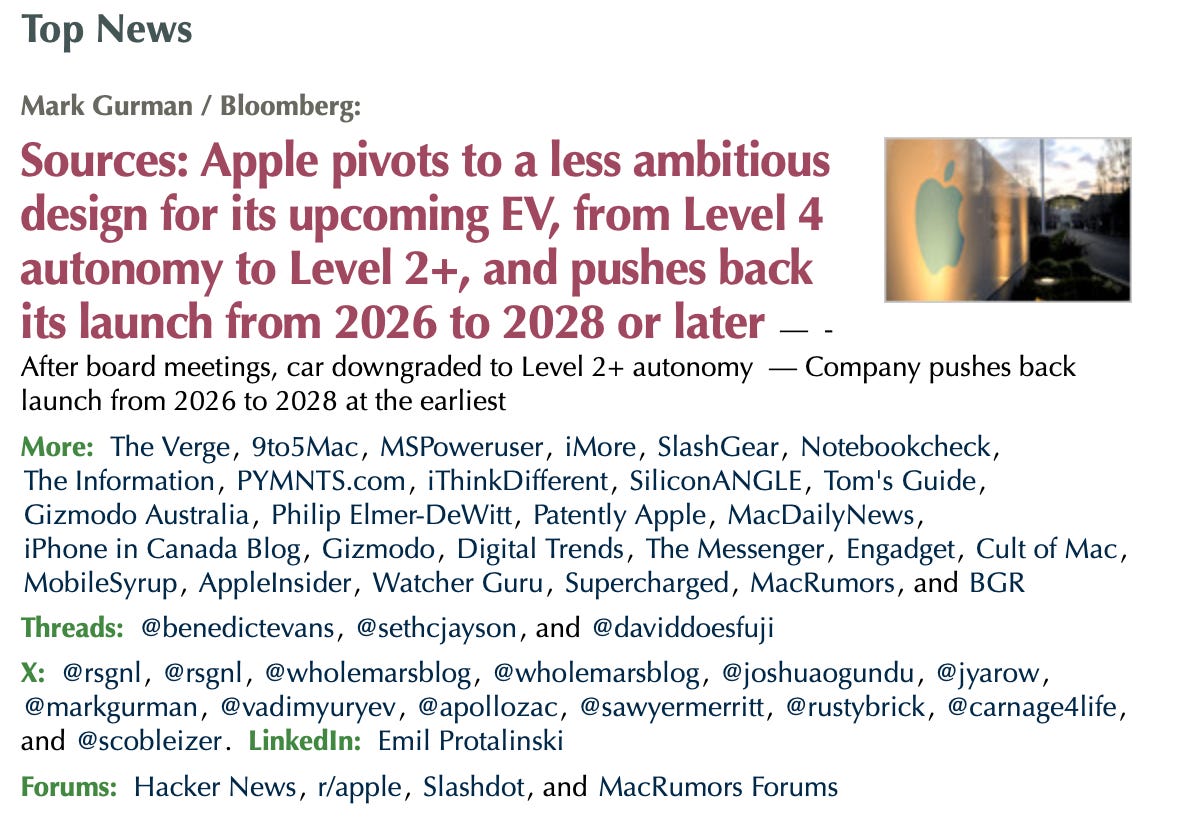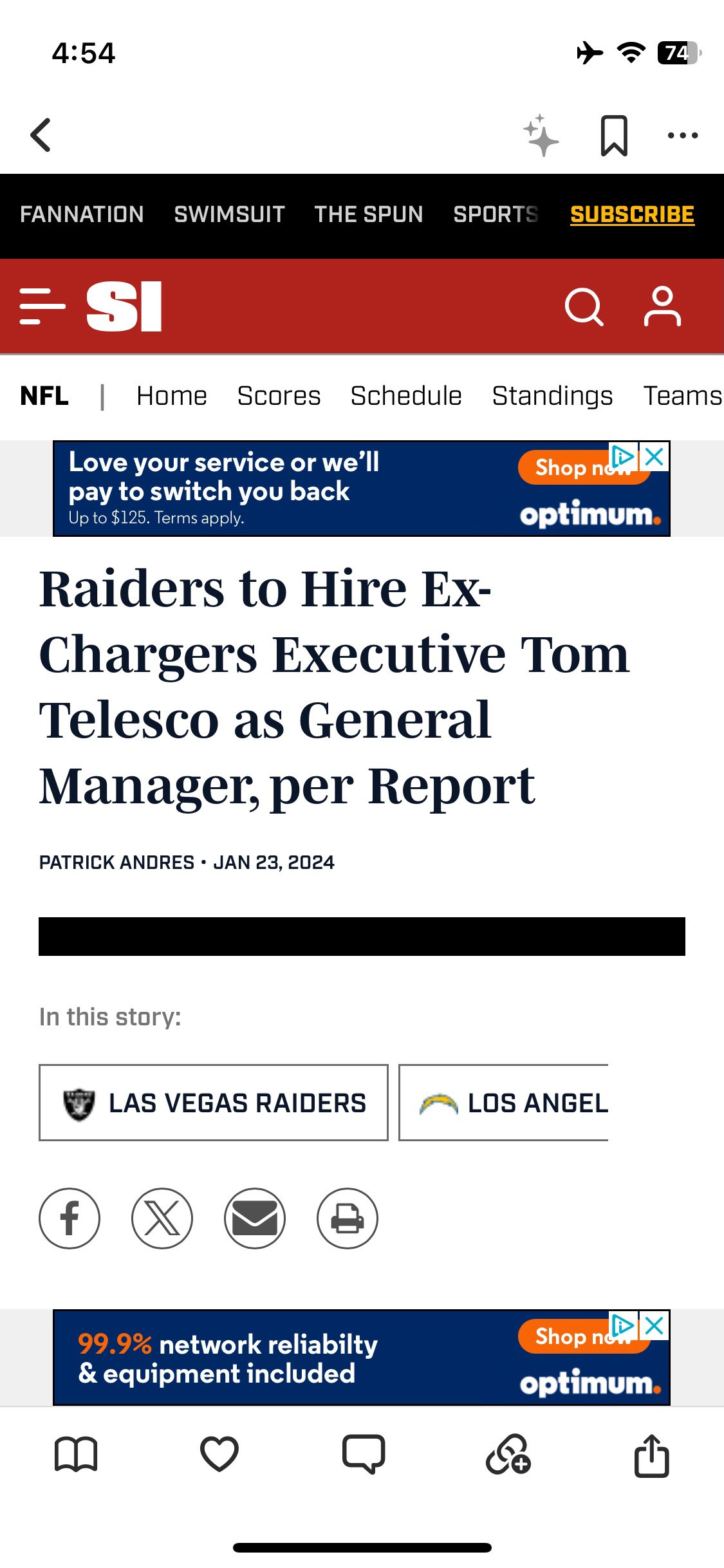AI News: A Provocative Business Flop
Artifact is shutting down. A saying holds again: garbage in, garbage out.
The Teardown
Thursday:: January 25th, 2024
👋 Hi, this is Chris with another issue of The Teardown. In every issue, I cover how daily life evolves in concert with the technology we use every day. If you’d like to get emails like this in your inbox every week, hit the subscribe button below.
Is AI coming for your job? Is AI taking over the news? Is AI on a crash course to doom the world or instead helping achieve some new goals in our professional and personal lives?
I don’t know the answers. If you do, let’s please get rich together. But my anecdotal view is this: AI is everywhere and has helped and hurt us as a collective society for some time. Let’s look at an example that didn’t help us much at all.
—
Kevin System and Mike Krieger announced on January 12th that they are shutting down their latest venture, Artifact. Kevin and Mike - we’re on a first-name basis - created Instagram.
Artifact is an app that uses machine learning to suggest the best content to you based on your profile and subsequent explicit interests. To start, it stuffs you into a series of categories when you sign up, and suggests numerous news stories. The span news articles and posts from around the internet, based in part on your user cohort so to speak. Signing up as a early-40s professional from the Northeast with interests in technology, music, and insurance means you’re fed articles aligned with those traits. I don’t know who we are talking about, by the way.
Artifact gives you mechanisms to indicate interest and share articles. Those mechanisms help it learn what you really want (e.g. F1 News) and deliver more of that stuff. Clicking and reading lots of F1 articles means you want more F1 content surfaced on your screen. An AI robot contemplates and delivers on your wishes.
Note that Artifact requires two key inputs:
Content
Users, and their interactions
If those inputs sound like the inputs to a quasi-social network, you’re not wrong. But Artifact isn’t designed so much as a social network but instead as a content-recommendation network. That aspirational pillar is topped by a company you probably know: TikTok
There are different ways to bootstrap networks, and I might add, anything that requires valuable interactions and relationships. One way is to provide exquisite content that draws people to the network due to content quality. Another is to cajole people to join and interact with each other within the network even if there isn’t much else there. The right amount of FOMO causes an explosion in usage.
But you need a viable starter set. Just one isn’t as great as both. An singular unimpressive version of one isn’t ideal.
Garbage In, Garbage Out
My background working in insurance pricing is instructive here. Underwriters at insurance companies use numerous inputs to derive premium quotes they deliver to prospective policyholders and agents. The underlying pricing or quoting algorithms are sensitive to their inputs. You might’ve tried to game a quoting website from someone like State Farm to see this dynamic in action. Disclaimer: I am not an attorney and did not command you to do that!
Telling a property insurance pricing algorithm that a building is brand-spankin’ new when it’s really thirty years old results in a miscalculated price for the underwriter and the prospective policyholder. That input gaff might be a mistake or it might be deliberate, but the input data aligns poorly with the actual insurable asset. The quote is some degree of inaccurate.
We colloquially call this: garbage in, garbage out. Inaccurate input produces inaccurate output. Another way to categorize the equation is in terms of quality. Conceptually, high-quality input results in high-quality output.
Thus, when the pricing robot sees low-quality input it produces stinky malformed junk. It can’t make lemonade from household trash. There are levels of quality, of course.
But that’s insurance underwriting. Forgive me for the rabbit hole. What about everything else?
Let’s say I set up an algorithm to suggest articles to you based on other articles you read. The twist is I’ve been discouraged from surfacing content from organizations with high-quality content. Those places pay their reporters, their writers, their editors. They don’t let pesky little algorithms give away their precious prose. Sure, you can read an article from the NY Times, but you won’t get the curated experience of reading the article on the NY Times website, or their physical paper.
So, the algorithm that’s supposed to give you all the stuff you want starts with the disadvantage of not providing the best experience to you.
Now what? Will you trust my algorithm to provide content? You might for a bit of time. Fatigue may take over as you don’t see or find what truly tickles your intellectual curiosity. This algorithm (i.e. app) won’t be something you recommend to your friends because it’s just not good enough. They won’t join you. So, the algorithm will grind itself into the mud in two ways:
It regurgitates some sub-par content with a sub-par experience
It starves from lack of signal. What do people care about? It always wants to know more.
Not AI News, Not Yet
With that in mind, Kevin and Mike described why they’re winding down the company:
We have built something that a core group of users love, but we have concluded that the market opportunity isn’t big enough to warrant continued investment in this way.
Translation (my opinion): people don’t like sub-par news experiences, and not enough people joined Artifact to catapult sub-par AI-recommended news recommendations into the stratosphere. The input garbage produced, well, lots of other garbage. Users lost interest. The experience was not good.
It’s easy for me to write with authority from my pedestal. I wrote twice about Artifact in prior articles. My second piece contained blobs of skepticism but some positivity:
The app quickly associates you with other people (i.e. the archetype) as a way of generating initial suggestions. And if you read just enough, it will be quite good at putting what you want front and center in the app from that point forward
What’s missing in my original analysis is the appreciation for content quality. Yes, Artifact is good at putting what I want front and center when I craft the right profile. But it does so without the polish and landscape of the content source. If I want to read NY Times articles, shouldn’t I just go to their website? Or use their app? Probably.
I used The NY Times but pick the high-quality publication of your choice. The point is simple: news originators are less and less interested in services that summarize their content or surface it to users without the right experience and credit. That’s one reason why The NY Times is suing OpenAI - a topic I want to get to soon.
The famed founders closed with a joint monologue on the state of news and information:
News and information remain critical areas for startup investment. We are at an existential moment where many publications are shutting down or struggling, local news has all but vanished, and larger publishers have fraught relationships with leading technology companies. My hope is that technology can find ways to preserve, support and grow these institutions and that these institutions find ways of leveraging the scale that things like AI can provide
There’s some irony in that closing. Can large organizations like the NY Times leverage the scale of AI? Sure. However, it is the scale of AI - and broadly algorithmic attention - that caused a smattering of the current problems. Many of the publications within the Artifact source list are, unfortunately, built for SEO optimization and advertising. Their reading experiences are fraught with pop-up ads, obtrusive modals, and other elements that degrade the consumption experience for readers. Artifact tries to bootstrap a business on the backs of news organizations that optimize using AI for their true constituents. By that, I mean, ads, engagement, metrics. I can’t blame them. These are for-profit businesses.
High-Quality Still Wins
Artifact’s shuttering reminded me of a long-running website that I’ve used as a resource for years: TechMeme. The site is a technology news aggregator that employs automation and a small amount of human touch to surface technology stories to readers. The TechMeme About page explains the basic premise:
In 2024, knowing what's changing in technology is required to understand the cultural currents and business events reshaping the world. If you've been watching the tech industry evolve, it won't surprise you that social networks enable political revolutions, brand new companies can acquire millions of customers in months, or the world's most valuable company built that wealth on products that didn't exist five years ago.
Techmeme is the foremost source for tracking these changes. By presenting a summary of the day's essential reports and analysis on a single page, TechMeme has become the technology news site of record for people both within and beyond the industry.
In these words, there’s not an estoric mission on which the company stands. The site seeks to aggregate technology news for readers. It makes money from obvious but not obtrusive advertising. It does just a bit of editorializing, rewriting headlines to add more descriptive wording. Most important is the fact that each headline post still links to the original article. To read something from the the NY Times, you have to go directly to The NY Times. There is no intermediary.
Whereas Artifact aims to popularize AI news for everyone, TechMeme began and still seeks to surface news about tech to tech consumers. Note that above I highlighted two components necessary to bootstrap a network:
Content
Users, and their interactions
What TechMeme has that Artifact probably does not have is lots of high-quality signal (i.e. #2 in the list) from users at the scale they aim to reach.
But, perhaps, the point worth appreciating more is the content. TechMeme surfaces news and editorializes a bit, but adds supplemental content to the source post.
The below screenshot highlights TechMeme’s true differentiation and one of many reasons to return:
As a tech enthusiast, it helps knowing that this story is covered not only by Bloomberg but also by The Verge, 9to5Mac, and more. Many of the publications in the More category are long-running high-quality sources of Apple information.
The more interesting augmentations are the social call-outs. I see story references from prominent journalists across social networks like Threads and Twitter (i.e. X). I see discussions burgeoning in places like Hacker News with strong, high-engagement communities. These signals help reinforce the quality of and interest in the original article.
Bad Experiences Doom Usage
TechMeme’s potent combination developed over time, but is key to why I think Artifact is winding down. Over time, Artifact may have gained the right blend of content and user signal to scale to a large business. Yet, it is today’s experience that matters. That experience is not as good as it could be.
As an example, here is Artifact’s Home Screen when I open it:
I’ll shove the specifics of the content aside. We have our own taste in news. Some of you may want to know more about Jason Kelce. But in gray below each headline is the number of “reads” - whatever that means.
That reads line is half of the problem. Is it the number of full reads? Number of clicks? Number of users? It’s not an obvious metric. The story with Jason Kelce and Taylor Swift has many more reads than the others. Does that make it more relevant to me?
The other half is the reading experience. Clicking on a Sports Illustrated story in that list results in this experience:
What’s not the there? The actual story. The screen is plastered with social buttons and ads. The text that I indicated I wanted isn’t accessible at all. I have to scroll to find it. Ugh.
I’m not picking on Sports Illustrated here as other Artifact sources mirror the same issue.
In short, we may want and ultimately use AI to deliver the right list or mix of ideas and content, but that list will need the best experience wrapped around that content to drive actual interest and usage.
We aren’t there yet.








